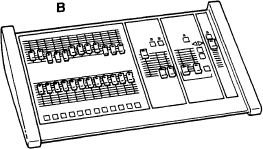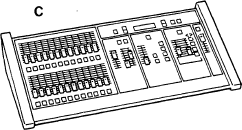Lighting Console
The function of the lighting console is to enable the lighting director to:
● Swiftly adjust the light output from the luminaires in use and so achieve a good lighting balance (i.e. appropriate relative intensities).
● Carry out any lighting changes required by the production.
● Reduce the heat build-up in the studio and power used, by switching out luminaires not immediately required. This also reduces the possibility of light spilling from adjacent sets.
Console design
The lighting console should be located in the vision control area. It should preferably:
● Be compact to facilitate one-man operation.
● Offer switching and brightness control on all the lighting channels.
● Be designed to facilitate productional lighting changes.
● Provide facilities for the quick selection and switching of a group of channels (memory system).
● Provide lighting effects, e.g. chasers, flickers, sound-to-light.
● Allow blind-plotting, i.e. creation of a lighting plot without affecting studio lighting.
● Be user-friendly i.e. easy and logical to operate.
Manual consoles
The simplest console design has two faders (or presets) per lighting channel, providing two lighting conditions controlled via two group master faders. Cross-fading between the groups can be manual or a timed dipless autocrossfade. A Grand Master fader gives overall control of the lighting condition. An extension of this console would be the inclusion of special effects facilities, e.g. chase, flicker, sound-to-light etc. and the facility for 0–10 V analogue control signals or DMX control signals.
Computer consoles
There are many micro-processor controlled consoles available which offer extremely versatile control of lighting conditions, moving lights and scrollers. ‘Soft-patch’ of faders to dimmers enable many dimmers to be controlled by a few faders. Memories which store channel intensity give the facility for presetting lighting plots (at least 100) and control their recall (lighting changes). In most computer consoles the many rows of faders are replaced with a few faders and a key-pad for channel/memory selection. They include a VDU to give display of channel levels, memories in use, timing information etc. Usually, these consoles provide a DMX control signal as standard, with an optional analogue 0–10 V.
Load meter
Finally, a load meter should be included near the lighting console to indicate the production lighting power consumption. It should have an indication of the maximum permissible load.
Typical 12 channel manual console, providing the facility of presetting two lighting conditions and crossfading between them. Also available in 18 and 24 channel versions.

B. Manual console with effects
12 or 24 channel available, this console provides the additional features of 12 or 24 effects, e.g. chase, flicker, etc, with DMX or analogue control systems.

C. Computer console
This microcomputer based console provides 24 channels/1 preset, or 12 channels/2 presets with soft patch of 96 dimmers, 999 memories, 24 effects, DMX output (analogue option), comprehensive monitoring of lighting conditions with LCD display.

D. Computer console and VDU
This type of console typically has 120 or 240 channels controlling via a soft patch up to 512 dimmers, allocation of dimmer law (from 9), storage of a complete show on a cue card, 24 submasters, independant DMX output for control of scrollers, 24 programmable chasers, 20 special effects, 255 memories, 2 submasters studio/preset, blind plotting VDU display.
Options include infra-red control (from studio floor).

